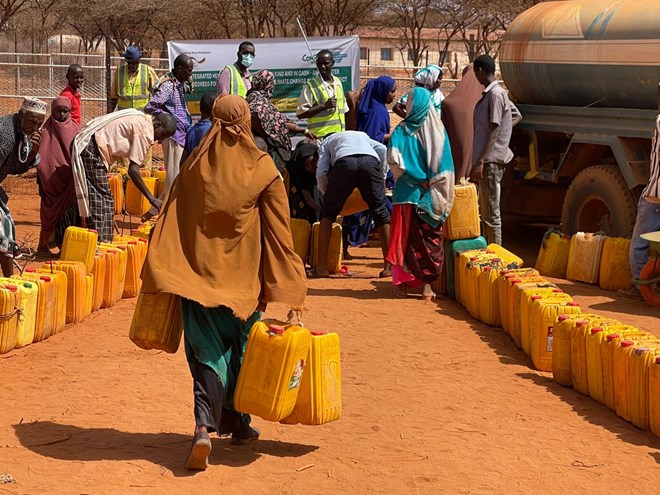
Wednesday March 22, 2023

A Somali woman walks to a water truck to fill up her containers for her family in Odweyne in the Toghdeer district (Photo: Concern Worldwide)
Mogadishu (HOL) - Millions of people in the Horn of Africa, which includes much of Somalia, Kenya, and Ethiopia, are facing an acute shortage of safe drinking water due to the longest drought on record. A recent report by the international aid organization Oxfam revealed that up to 90% of water boreholes in some parts of the region have dried up completely. This has caused water prices to rise by 400% since January 2021 in some areas of Ethiopia, northern Kenya, and Somalia. As a result, more than 22.7 million people are facing acute hunger, making it difficult for them to access the remaining water.
The region is experiencing its worst drought in 40 years, with the sixth straight rainy season expected this year. Drought, conflict, and political instability have displaced millions across the region.
The drought, which has lasted for over two years, has already claimed the lives of over 13 million livestock and displaced 1.75 million people in search of food and water. The crisis has disproportionately affected women, children, persons with disabilities, and marginalized groups/clans, with over 80% of Somalia's drought-displaced population made up of women and children.
Water prices have more than doubled in the Bay region of Somalia, where 76,000 people are already facing famine-like conditions. Families are forced to sell their essential possessions or move in search of water. Additionally, hundreds of thousands of people are relying on emergency water trucking, which is unsafe and contaminated. Without clean water, people are at risk of contracting easily preventable diseases like acute watery diarrhea and cholera.
According to Fati N'Zi-Hassane, Oxfam in Africa Director, "the hungriest people in the region are also the thirstiest. People have depleted their last penny as they lost their crops and animals. They now have to pay vendors who continuously hike water prices." Moreover, while famine has been averted in countries like Somalia, mainly due to increased humanitarian response, only 20% of the UN's $7 billion appeal for Ethiopia, Kenya, and Somalia has been funded to date. This shortfall will derail efforts to help millions of people on the brink.
According to the UN, about 7.9 million people in Somalia alone, nearly half of the population, need humanitarian assistance. A recent report released by the UN children's agency, the World Health Organization, and the Somali government estimated that more people died last year than in the first year of the 2017-2018 drought crisis. The report projects that at least 135 people will die each day in Somalia due to the drought crisis, with 18,100 to 34,000 drought-related deaths in the first six months of this year.
Somalia's Health Minister Ali Hadji Adam Abubakar said his government is "concerned about the level and scale of the public health impact of this deepening and protracted food crisis in Somalia." However, he is also "optimistic that if we can sustain our ongoing and scaled-up health and nutrition actions and humanitarian response to save lives and protect the health of our vulnerable, we can push back the risk of famine forever. Otherwise, those vulnerable and marginalized will pay the price of this crisis with their lives."
As of February 9, 2023, humanitarian groups are seeking $2.6 billion to assist 7.6 million people in Ethiopia, Kenya, and Somalia, but funding remains insufficient, with unmet requirements of $1.97 billion.
Initiatives such as social protection and cash transfer programs have supported families and built resilience against future disasters, and improving water systems will be crucial to tackling the impact of climate change.